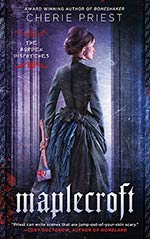
![]() thejessleigh
thejessleigh
6/10/2019
![]()
Maplecroft is at its best when the monsters are just out of sight, and loses some of its effectiveness when the characters start to discover science behind their origins and weaknesses. The diary format, deliberate withholding of information, and constant miscommunication remind me a lot of the way that Dracula is structured, and followed several similar beats. I enjoyed Maplecroft, but felt that the resolution didn't live up to the buildup. It's obviously set up to be the first installment in a series. I'm curious where it might go from here, but I would have liked it to stand alone a little better.
I was wary when I learned one of the main characters is employed at Miskatonic University, thinking that Priest might be pulling too much directly from the Lovecraft universe. However, I think that she did a good job of working within the strangeness of that universe, rather than getting to mired in some of the more difficult and problematic aspects of Lovecraft's universe. This is a good, pulpy horror read and I would recommend this to anyone who is into that sort of thing. However, I don't think it will convert anyone who isn't already sold on the premise.
I appreciate reading a gothic horror where the two main players are women, especially since there's a lesbian relationship involved. It's a breath of fresh air compared to Lovecraft and his white, male, flat narrators. (I understand that Lovecraft was doing more with atmosphere than he was with characterization. It's just nice to see some of the same atmospheric work happen with a variety of voices.)
The blurb for the sequel indicates that Lizzie will be the protagonist of the next, which makes sense, as she is the character ripped straight from the (1890s) headlines. Unfortunately, I found her to be the least interesting of all the narrators. I look forward to reading more about Inspector Wolf and his mysterious organization in the next installment.